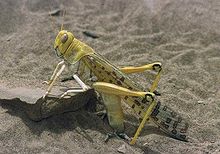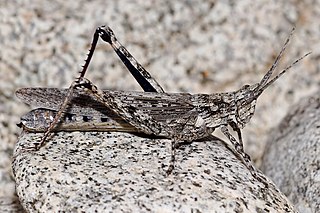
The Acrididae are the predominant family of grasshoppers, comprising some 10,000 of the 11,000 species of the entire suborder Caelifera. The Acrididae are best known because all locusts are of the Acrididae. The subfamily Oedipodinae is sometimes classified as a distinct family Oedipodidae in the superfamily Acridoidea. Acrididae grasshoppers are characterized by relatively short and stout antennae, and tympana on the side of the first abdominal segment.
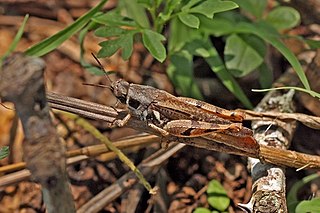
The subfamily Catantopinae is a group of insects classified under family Acrididae. Genera such as Macrotona may sometimes called "spur-throated grasshoppers", but that name is also used for grasshoppers from other subfamilies, including the genus Melanoplus from the Melanoplinae. Indeed, the delimitation of these two subfamilies needs restudy: the Podismini for example are sometimes placed here, sometimes in the Melanoplinae.

Bandwings, or band-winged grasshoppers, are the subfamily Oedipodinae of grasshoppers classified under the family Acrididae. They have a worldwide distribution and were originally elevated to full family status as the Oedipodidae. Many species primarily inhabit xeric weedy fields, and some are considered to be important locusts:

The grasshopper subfamily Acridinae, sometimes called silent slant-faced grasshoppers, belong of the large family Acrididae in the Orthoptera: Caelifera.

The red locust is a large grasshopper species found in sub-Saharan Africa. Its name refers to the colour of its hind wings. It is sometimes called the criquet nomade in French, due to its nomadic movements in the dry season. When it forms swarms, it is described as a locust.
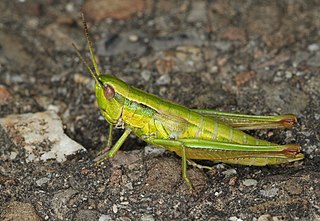
Gomphocerinae, sometimes called "slant-faced grasshoppers", are a subfamily of grasshoppers found on every continent but Antarctica and Australia.

Anacridium moestum, the camouflaged tree locust, is a species of grasshopper belonging to the family Acrididae, that is native to Africa south of the equator. It is similar in appearance to the Southern African desert locust, Schistocerca gregaria flavicentris. It is likewise brownish, large and slender, but mostly arboreal in its habits.

Anacridium is a genus of "tree locusts" or "bird grasshoppers" belonging to the subfamily Cyrtacanthacridinae.

Oxyinae is subfamily of grasshoppers in the family Acrididae. Species are distributed throughout Africa and Australasia.

Patanga is a genus of grasshoppers in the subfamily Cyrtacanthacridinae. Species are distributed throughout Asia: from India, China, Japan, Indochina and western Malesia. The genus was named by Boris Uvarov in 1923, with the type species the economically significant Bombay locust: which has also been placed in genus Nomadacris.

Podismini is a tribe of "spur-throated grasshoppers" in the family Acrididae. This tribe is unlike others in the subfamily Melanoplinae in that a substantial number of genera occur outside the Americas.

The Hemiacridinae are a subfamily of Acrididae in the Orthoptera: Caelifera. Species can be found in Africa, and Asia.

Xenocatantops is a genus of grasshoppers in the subfamily Catantopinae and tribe Catantopini. Species can be found in Africa, India, China, Indo-China and Malesia.
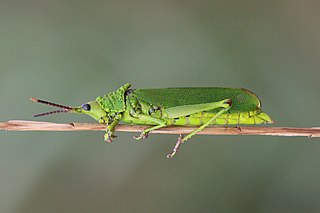
The Pyrgomorphinae are a sub-family of grasshoppers in the family Pyrgomorphidae. Species are found in, especially the warmer parts of: Central and South America, southern Europe, Africa, Asia, Australia and Pacific Islands. The type genus is Pyrgomorpha and names dates from "Pyrgomorphiden" by Brunner von Wattenwyl, 1874. The first use of Pyrgomorphinae was by Krauss in 1890.

The Orthacridinae are a sub-family of grasshoppers in the family Pyrgomorphidae. Species are found in: Central America, Africa, Asia, Australia and certain Pacific Islands. The type genus is Orthacris and the taxon proposed by Bolívar in 1905.

Eucoptacra is a genus of grasshoppers in the family Acrididae and subfamily Coptacrinae. Species can be found in: Africa, India, Indo-China, peninsular Malaysia and Borneo.

The Phlaeobini are a tribe of grasshoppers in the subfamily Acridinae. The recorded distribution of genera includes: Africa, the Middle East and Asia.

Schistocerca pallens is a large “bird grasshopper” in the subfamily Cyrtacanthacridinae that occurs throughout tropical America. It is closely related to Schistocerca cancellata but shows no swarming behaviour or locust phase polymorphism, even under crowded laboratory conditions. Although not a swarming locust, it can occur at sufficiently high densities to cause economic damage. It is mainly a pest of sugar cane, but has also been recorded as damaging almond, banana, beans, breadfruit, carnauba wax palm, chickpeas, coconut palms, cotton, forage crops, groundnuts, indigo, legumes, maize, onions, rice, sorghum, sweet potato and tomatoes.
The Euryphyminae are a subfamily of grasshoppers in the family Acrididae, based on the type genus Euryphymus and may be called "agile grasshoppers"; it was erected by Vitaly Michailovitsh Dirsh in 1956. Species have been recorded from parts of sub-Saharan Africa including Madagascar.
